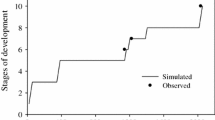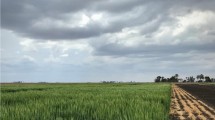Abstract
Crop simulation models have been used successfully to evaluate many systems and the impact of change on these systems, e.g. for climatic risk and the use of alternative management options, including the use of nitrogen fertilisers. However, for low input systems in tropical and subtropical regions where organic inputs rather than fertilisers are the predominant nutrient management option and other nutrients besides nitrogen (particular phosphorus) constrain crop growth, these models are not up to the task. This paper describes progress towards developing a capability to simulate response to phosphorus (P) within the APSIM (Agricultural Production Systems Simulator) framework. It reports the development of the P routines based on maize crops grown in semi-arid eastern Kenya, and validation in contrasting soils in western Kenya and South-western Colombia to demonstrate the robustness of the routines. The creation of this capability required: (1) a new module (APSIM SoilP) that simulates the dynamics of P in soil and is able to account for effectiveness of alternative fertiliser management (i.e. water-soluble versus rock phosphate sources, placement effects); (2) a link to the modules simulating the dynamics of carbon and nitrogen in soil organic matter, crop residues, etc., in order that the P present in such materials can be accounted for; and (3) modification to crop modules to represent the P uptake process, estimation of the P stress in the crop, and consequent restrictions to the plant growth processes of photosynthesis, leaf expansion, phenology and grain filling. Modelling results show that the P routines in APSIM can be specified to produce output that matches multi-season rotations of different crops, on a contrasting soil type to previous evaluations, with very few changes to the parameterization files. Model performance in predicting the growth of maize and bean crops grown in rotation on an Andisol with different sources and rates of P was good (75–87% of variance could be explained). This is the first published example of extending APSIM P routines to another crop (beans) from maize.







Similar content being viewed by others
References
Daroub SH, Gerakis A, Ritchie JT, Friesen DK, Ryan J (2003) Development of a soil-plant phosphorus model for calcareous and weathered tropical soils. Agric Syst 76:1157–1181. doi:10.1016/S0308-521X(02)00082-3
FAO/UNESCO (Food and Agriculture Organization of the United Nations and United Nations Educational Scientific, and Cultural Organization) (1990) Soil map of the World: revised legend. Rome, Italy
Heal OW, Anderson JM, Swift MJ (1997) Plant litter quality and decomposition: an historical overview. In: Cadisch G, Giller KE (eds) Driven by nature: plant litter quality and decomposition. CAB International, Oxon, pp 3–30
Hedley MJ, Stewart JWB, Chauhan BS (1982) Changes in inorganic and organic soil phosphorus fractions induced by cultivation practices and by laboratory incubations. Soil Sci Soc Am J 46:970–976
Iyamuremye F, Dick RP (1996) Organic amendments and phosphorus sorption by soils. Adv Agron 56:139–185. doi:10.1016/S0065-2113(08)60181-9
Jones CA (1983) A survey of the variability in tissue nitrogen and phosphorus concentrations in maize and grain sorghum. Field Crops Res 6:133–147. doi:10.1016/0378-4290(83)90053-9
Jones CA, Kiniry JR (eds) (1986) CERES-maize: a simulation model of maize growth and development. A&M University Press, College Station, p 194
Jones PG, Thornton PK (1999) MarkSim: software to generate daily weather data for Latin America and Africa. Agron J 92:445–453
Jones CA, Cole CV, Sharpley AN, Williams JR (1984) A simplified soil and plant phosphorus model: I. Documentation. Soil Sci Soc Am J 48:800–805
Jones PG, Thornton PK, Diaz W, Wilkens PW (2002) MarkSimTM: a computer tool that generates simulated weather data from crop modelling and risk assessment: Version 1. CIAT
Keating BA, Carberry PS, Hammer GL, Probert ME, Robertson MJ, Holzworth D, Huth NI, Hargreaves JNG, Meinke H, Hochman Z, McLean G, Verburg K, Snow V, Dimes JP, Silburn M, Wang E, Brown S, Bristow KL, Asseng S, Chapman S, McCown RL, Freebairn DM, Smith CJ (2003) An overview of APSIM, a model designed for farming systems simulation. Eur J Agron 18:267–288. doi:10.1016/S1161-0301(02)00108-9
Kinyangi J, Delve RJ, Probert ME (2004) Testing the APSIM model with data from a phosphorus and nitrogen replenishment experiment on an Oxisol in Western Kenya. In: Delve RJ, Probert ME (eds) Modelling nutrient management in tropical cropping systems. ACIAR Proceedings No. 114, pp 101–109
Le Mare PH, Leon LA (1989) The effects of lime on adsorption and desorption of phosphate in five Colombian soils. Eur J Soil Sci 40:59–69. doi:10.1111/j.1365-2389.1989.tb01254.x
Micheni AN, Kihanda FM, Probert ME, Warren GP (2004) Testing APSIM model with Machanga (Embu) long-term manure application experimental data. In: Delve RJ, Probert ME (eds) Modelling nutrient management in tropical cropping systems. ACIAR Proceedings No. 114, pp 110–117
Nye PH, Tinker PB (1977) Solute movement in the soil-root system. Blackwell, Oxford
Palm CA, Myers RJK, Nandwa SM (1997) Combined use of organic and inorganic nutrient sources for soil fertility maintenance and replenishment. In: Buresh RJ, Sanchez PA, Calhoun F (eds) Replenishing soil fertility in Africa. SSSA Special Publication No. 51, pp 93–217
Probert ME (1985) A conceptual model for initial and residual responses to phosphorus fertilizers. Fertil Res 6:131–138. doi:10.1007/BF01051007
Probert ME (2004) A capability in APSIM to model P responses in crops. In: Delve RJ, Probert ME (eds) Modelling nutrient management in tropical cropping systems. ACIAR Proceedings No. 114, pp 92–100
Probert ME, Dimes JP (2004) Modelling release of nutrients from organic resources using APSIM. In: Delve RJ, Probert ME (eds) Modelling nutrient management in tropical cropping systems. ACIAR Proceedings No. 114, pp 25–31
Probert ME, Keating BA (2000) What soil constraints should be included in crop and forest models? Agric Ecosyst Environ 82:273–281. doi:10.1016/S0167-8809(00)00231-0
Probert ME, Okalebo JR (1992) Effects of phosphorus on the growth and development of maize. In: Probert ME (ed) A search for strategies for sustainable dryland cropping in semi-arid Eastern Kenya. ACIAR Proceedings No. 41, pp 55–62
Probert ME, Carberry PS, McCown RL, Turpin JE (1998a) Simulation of legume-cereal systems using APSIM. Aust J Agric Res 49:317–327. doi:10.1071/A97070
Probert ME, Dimes JP, Keating BA, Dalal RC, Strong WM (1998b) APSIM’s water and nitrogen modules and simulation of the dynamics of water and nitrogen in fallow systems. Agric Syst 56:1–28. doi:10.1016/S0308-521X(97)00028-0
Probert ME, Delve RJ, Kimani SK, Dimes JP (2005) Modelling nitrogen mineralization from manures: representing quality aspects by varying C:N ratios of sub-pools. Soil Biol Biochem 37:279–287. doi:10.1016/j.soilbio.2004.07.040
Rao IM, Friesen DK, Osaki M (1999) Plant adaptation to phosphorus-limited tropical soils. In: Pessarakli M (ed) Handbook of plant and crop stress. Marcel Dekker, New York, pp 61–96
Robertson MJ, Carberry PS, Huth NI, Turpin JE, Probert ME, Poulton PL, Bell M, Wright GC, Yeates SJ, Brinsmead RB (2002) Simulation of growth and development of diverse legume species in APSIM. Aust J Agric Res 53:429–446. doi:10.1071/AR01106
Sahrawat KL, Rego TJ, Burford JR, Rahman MH, Rao JK, Adam A (1995) Response of sorghum to fertilizer phosphorus and its residual value in a vertisol. Fert Res 41:41–47. doi:10.1007/BF00749519
Sommer R, Wall PC, Govaerts B (2007) Model-based assessment of maize cropping under conventional and conservation agriculture in highland Mexico. Soil Tillage Res 94:83–100. doi:10.1016/j.still.2006.07.007
Takahashi T, Shoji S (2002) Distribution and classification of volcanic ash soils. Glob Environ Res 6(2):83–97
Tiessen H, Moir JO (1993) Characterization of available P by sequential extraction. In: Carter MR (ed) Soil sampling and methods of analysis. CRC Press, Boca Raton, pp 75–86
USDA (United States Department of Agriculture) (1998) Keys to soil taxonomy. Washington, DC
Acknowledgments
The financial support of Australian Centre for International Agricultural Research is acknowledged (Project LWR2/1999/03 ‘Integrated nutrient management in tropical cropping systems: Improved capabilities in modelling and recommendations’). John Hargreaves (CSIRO, Toowoomba, Australia) is thanked for coding the phosphorus routines into the APSIM Plant module.
Author information
Authors and Affiliations
Corresponding author
Additional information
Dr R. J. Delve has recently left CIAT and joined Catholic Relief Services, Kenya.
Rights and permissions
About this article
Cite this article
Delve, R.J., Probert, M.E., Cobo, J.G. et al. Simulating phosphorus responses in annual crops using APSIM: model evaluation on contrasting soil types. Nutr Cycl Agroecosyst 84, 293–306 (2009). https://doi.org/10.1007/s10705-008-9243-6
Received:
Accepted:
Published:
Issue Date:
DOI: https://doi.org/10.1007/s10705-008-9243-6




